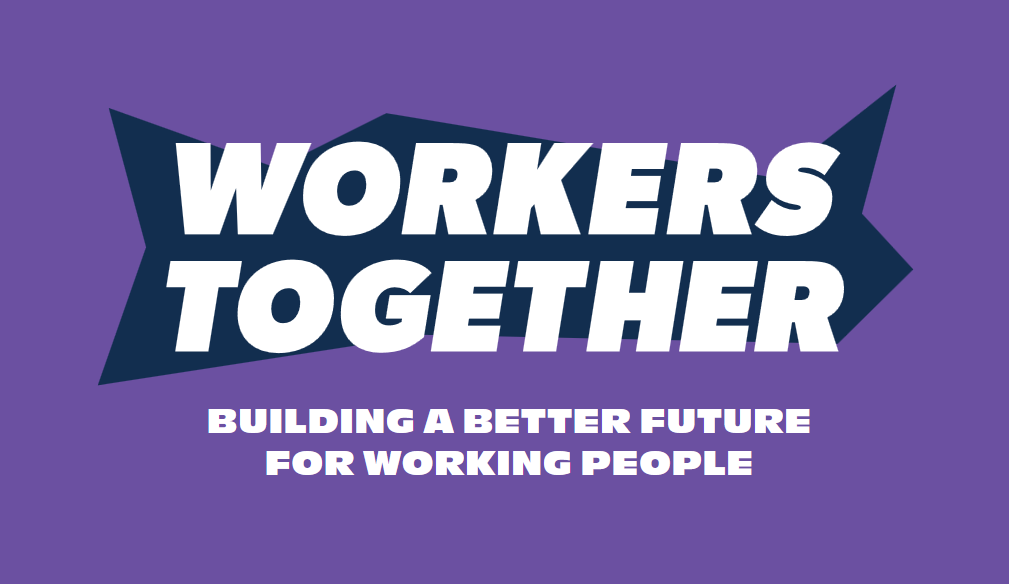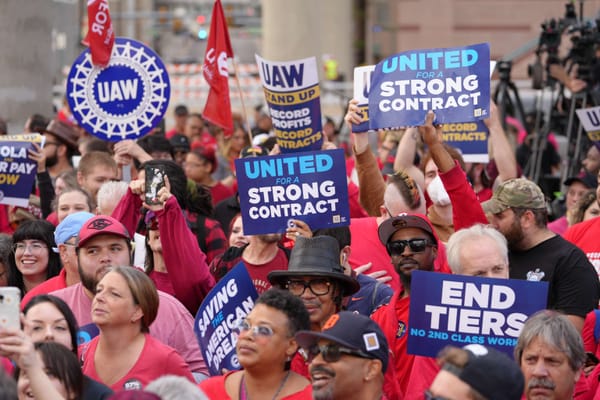
This week, workers at Lennox and Addington Interval House (LAIH) in Napanee, Ont., ended their five month strike when they ratified a new collective agreement. Workers at LAIH serve women and families escaping domestic violence and are members of Unifor Local 414.
The union had attempted to bargain a new collective agreement for a year before going on strike in October 2021. Their new contract includes a 9 per cent wage increase over four years, and improved hiring language and grievance procedures.
In many respects, this strike encapsulated the challenges facing workers — particularly women — across the care economy, such as the growth of precarious employment and employer disrespect. The issues that precipitated job action, as well as the resolve of Unifor members, therefore offer both lessons and inspiration.
This week I sat down with Brooke Phillips-Janisse, a child and youth worker at LAIH and member of the union bargaining team, to discuss the strike and the new contract.
Brooke has worked in the areas of housing, homelessness and domestic violence for the past 20 years. She and I share the honour of calling Napanee our hometown. Brooke has been an employee at Interval House since 2008 and a residential services worker since 2015.
Adam King: Can you tell us about L&A Interval House and the workforce there?
Brooke Phillips-Janisse: The L&A Interval House is unique in that it covers the entire large county of Lennox and Addington. We deal primarily with women and families fleeing domestic violence, but in a rural setting that has its own particular challenges. For example, it’s difficult to maintain confidentiality in a rural community where people are more likely to know one another.
The staff team at Interval House is diverse. Some staff have been here for more than 15 years, often working in different roles, in our shelter, in housing support or with children impacted by domestic violence. Although it’s a relatively small staff complement of about 20 people, there’s been limited turnover over the years.
AK: When did the strike begin and what were the main issues which led you to the picket line?
BPJ: We began our strike on Oct. 29, 2021, about five months ago. We’re members of Unifor Local 414 and have been for about 20 years.
The employer had said that if we didn’t accept their previous offer, there’d be no end in sight to the strike. That was pretty accurate until this past week.
In many ways, our collective agreement was extremely out of date, so we were essentially trying to update and modernize it. For example, we lacked provisions around progressive discipline, so workers would often face a huge file of breaches with no prior notice. We also wanted language in the contract that made sure workers had union representation at any disciplinary meeting.
The way the shelter is run has changed considerably over the past five years. We began to see some staff turnover and newly vacant positions weren’t being filled. This meant that current staff saw their tasks expand and were expected to take on a lot more work, at a time when our clients were also experiencing a growing complexity of issues.
We also saw an increase in the number of people in precarious, “part-time” positions without the benefits, sick pay or vacation entitlement of other staff. These folks were still working full-time hours, but at a reduced rate of pay.
As we entered negotiations, that was our biggest question: “If there is funding allocated specifically for staffing, why is it not being utilized to address this precarious employment?” We wanted the women who work here in stable employment. From a feminist perspective, we have to support the women who do this work as much as the women who use our services.
AK: Over the course of the strike, did the union make any bargaining progress?
BJP: We made some, but it was relatively minor. There was negotiation and movement on the progressive discipline issues and on hiring practices. But until very recently we were at an impasse concerning our three main issues: precarious employment, greater union protection and transparent disciplinary practices.
The union passed our previous bargaining proposal to the employer on February 25, but we didn’t receive any response until now. We were given the impression from the employer’s lawyer that they were working on a counter-proposal, but nothing seemed certain.
The board of directors was basically absent throughout the strike, even though they could have helped to address our issues and end the strike. The employer was simply not accountable for how they were spending taxpayer funding, such as using it to hire a high-priced lawyer to bargain hard with staff.
We also didn’t bargain over wages at the outset because the employer maintained that Interval House was subject to Bill 124, which caps public sector wages in Ontario at 1 per cent annually. In fact, this turned out to be false. Bill 124 only applies if a non-profit agency received $1 million or more of provincial funding in 2018-19, which LAIH didn’t. But we had no public audit trail to verify that at the time.
Even still, if the employer had addressed our other bargaining issues, we would have tolerated the 1 per cent pay increase. Instead, the employer forced us into a five month strike.
AK: What impact do you think the pandemic had on work at Interval House?
BPJ: Like other essential workers, Interval House staff continued to go to work. We had the typical increased workload of cleaning and trying to ensure a safe workplace, along with the added emotional stress of worrying about the virus. We of course had to additionally think about the health and safety of the women and children we house and serve.
We were also attuned to what was really a silent pandemic of people being at home and in many cases experiencing domestic violence from which they had no reprieve. School and service closures exacerbated the effects of domestic violence for a lot of women and children.
In our workplace, the pandemic fractured our team in some ways. We didn’t cross paths or have staff meetings and when we asked to do those things virtually, we were told it wasn’t a priority. There were times on strike when two workers saw one another for the first time in a year!
The strike — although exhausting — has brought our team back together and made us see how much stronger we are collectively.
AK: I can certainly relate. Gruelling strikes can nevertheless be a great team building exercise.
BPJ: I would have much rather done it at a spa, but it’s true. As a small group of workers, we managed to stay on strike seven days a week for almost five months.
AK: Striking in a small community presents its own set of challenges. How did the local community and other unions respond to your strike?
BPJ: The community was very supportive. Other unions were as well. Our local — Unifor 414 — is huge and spans workplaces from Toronto to Ottawa, so we had plenty of support. People from labour councils in Kingston and Quinte, from the Public Service Alliance of Canada, from the Ontario Nurses’ Association, all came out to support us on the line.
Strikes are often a huge financial hit. But other unions and the community made contributions to our strike fund and ensured that no one lost their home and went into debt. It was a huge relief to not be financially starved back to work.
It was surprising and quite refreshing to see how many people are involved in the labour movement in such a small community.
That said, it’s still a small place with a lot of nepotism, so the strike also divided people. For example, the mayor has a longstanding relationship with the director at Interval House. We suspect that she put in a few calls to disrupt our picket plans, especially as winter set in and we tried to erect a semi-permanent structure to stay warm. I never thought I’d be fighting so much over a portable toilet!
Our neighbours were also very gracious and understanding, even though they had to put up with our rallies, our music and horns honking in support. Our workplace is in a residential area, right on the main street that connects downtown to the 401 highway. But people knew we struck because we were out of options.
AK: The demographics of the labour movement have changed considerably over the years, along with the types of workplaces that unions represent. Women — especially those working in the care economy, such as nurses, teachers and social service workers — make up a much larger portion of union members now. Your strike really seemed to escapulate many of the issues faced by female union members in the care sectors.
BPJ: This is the only labour I’ve done in my career — in the “helping” professions. Many of the other service providers that Interval House interacts with are also female-dominated and unionized. When we went on strike, these colleagues knew the emotional toll of choosing to walk off the job at a workplace like ours. We knew that with our strike action, women and children would not receive the level of care we normally provide — and that they’re entitled to.
We thought — perhaps naively — that the needs of our clients would incentivize the employer to bring this to a resolution much quicker. But the narrative we heard throughout was, ‘Everything is running smoothly without you.’ We know that there’s no way that was possible given the level of need for our services in the community.
AK: The employer resorted to using scabs.
BPJ: Yes, we believe there were three or four scabs working in the shelter, one private practitioner contracted to do outreach, and one retired shelter manager doing work remotely.
AK: Thankfully, the contract has been ratified and many of the union’s priorities have been addressed. When it comes to collective bargaining and strikes in care workplaces, unions are fighting not only to improve pay and working conditions but also to ensure quality service delivery. Teachers often say “our working conditions are student’s learning conditions,” and it’s similar in this case: your working conditions are clients’ service conditions.
BPJ: Absolutely. We truly believe that this is a feminist organization, that we’re here to empower women to see their value and their worth.
How could we empower the women we serve if we weren’t willing to stand up for ourselves? How can I be an advocate and not fight for myself and my coworkers?







